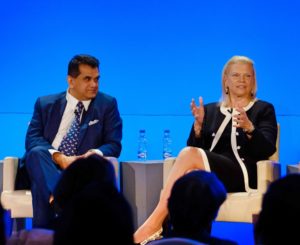IBM today announced significant collaborations across India that will advance the skills and careers of more than 200,000 (2 lakh) female students in Science, Technology, Engineering and Math (STEM) fields. The collaborations begin today with the signing of agreements with three state governments—Karnataka, Telangana and Andhra Pradesh—and are planned to widen to several other states in the next few months.
The demand for a highly qualified workforce in India is quickly increasing with the acceleration of emerging technologies like Cloud and AI. Each collaboration between IBM and Indian state governments is part of a three-year programme to increase the participation of girls and women in STEM careers. They feature a comprehensive approach that builds technical capabilities as well as life and self-actualization skills. The programme will equip women with the skills of the future to help drive the economy of the next decade.
The new programme is one of several initiatives announced at the IBM India Skills Forum hosted in New Delhi today. Together, these efforts have the potential to improve the skills and careers of more than 1 million female students and provide educational resources to more than 4 million teachers over three years.

Ginni Rommetty, Chairman & CEO, IBM with Amitabh Kant, CEO, Niti Aayog
“Partnering with the Indian government, we are investing in the empowerment of millions of young women and their teachers with training in STEM skills, so that India’s growing economy has the right resources and more women in the workforce,” said Ginni Rometty, IBM chairman, president and CEO, speaking at the India Skills Forum. “We know that AI, like other transformative technologies before it, will have a profound impact on jobs and the workplace. We need to work together to equip the workforce with a new generation of skills, so the benefits of AI and technology can be experienced by the many, not just a few.”
The need to provide the right learning opportunities was also confirmed by Shri Amitabh Kant, CEO of NITI Aayog, the National Institution for Transforming India.
“There is an impending need for collaboration between government, industry and academia to bridge the skills gap in the workforce,” he said. “Although India has made rapid strides to address this in the past five years, IBM, as a role model for this industry, is setting a standard with its commitment to upskilling programmes. By engaging with the government and academia, IBM is equipping India’s women with the right skills for jobs of the future, keeping in mind the diverse nature of the country. I hope that we continue to see players from other organisations in the industry invest in the future of India and assist with bettering our skills as we continue to compete globally.”
New Initiatives
IBM announced the following initiatives addressing India’s skills and educational needs:
- A collaboration with state governments across India to prepare 200,000+ girls and women in government schools over the next three years for “new collar” jobs through the exploration and study of STEM subjects in classrooms and online.
- A two-year Advanced Diploma Programme in emerging technologies created in collaboration with the Ministry of Skill Development & Entrepreneurship, which will be available to 100 Industrial Training Institutes (ITI), including 50 all-women ITIs, over the next three years. IBM will also offer internships of up to five months to some students, presenting an opportunity for them to further deepen their skills and understanding in emerging fields such as Cloud and AI.
- In collaboration with the Kendriya Vidyalaya schools network, IBM will continue to support math teachers across India with Teacher Advisor With Watson. This free, AI-powered instructional resources website enables educators to easily receive targeted recommendations to deliver hhigh-qualitylessons, activities and strategies.
- Teachers TryScience resources will be made accessible to four million teachers in the Indian Open Educational Resources community for STEM. This unique online repository of STEM-related lessons, teaching strategies, best practices and other resources has been developed over five years through engagements with 55,000 trainers in India, covering 12 states and nine Indian languages.
- As part of IBM’s ongoing engagement with the Government of India targeting young innovators through the Atal Tinkering Labs initiative, some 4,000 mentors and 600,000 mentees will benefit from a unique AI-powered Mentor Platform. Developed with the IBM Watson cognitive engine, the platform will monitor mentor and mentee interactions to provide personalized support to those using the platform. IBM has thus far onboarded 2,500 mentors, including 300 IBMers, to this platform by collaborating with the national Mentor of Change mission.
IBM’s commitment in India comes as part of a multipronged global initiative to close the STEM skills gap and prepare the workforce worldwide for new collar careers. Eight years ago, IBM launched Pathways to Technology Early College High School, or P-TECH, which better prepares students by combining high school, an associate’s degree and on-the-job training. Today P-TECH has 200 schools in 13 countries and is on-track to serve 125,000 students. IBM also launched an apprenticeship programme in 2017, a proven approach to on-the-job training, focusing on in-demand careers like software development, design and cybersecurity. That programme has grown twice as fast as expected, with 91% of apprentices on average find work after completing their program.









